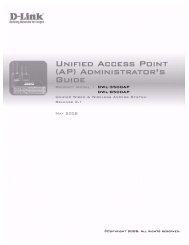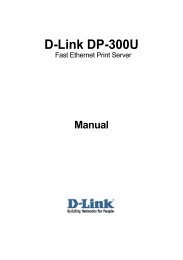Product Manual
Product Manual
Product Manual
Create successful ePaper yourself
Turn your PDF publications into a flip-book with our unique Google optimized e-Paper software.
DES-3526 / DES-3526DC Fast Ethernet Layer 2 Switch<br />
• To help prevent electric shock, plug the system and peripheral power cables into properly grounded electrical outlets.<br />
These cables are equipped with three-prong plugs to help ensure proper grounding. Do not use adapter plugs or<br />
remove the grounding prong from a cable. If you must use an extension cable, use a 3-wire cable with properly<br />
grounded plugs.<br />
• Observe extension cable and power strip ratings. Make sure that the total ampere rating of all products plugged into<br />
the extension cable or power strip does not exceed 80 percent of the ampere ratings limit for the extension cable or<br />
power strip.<br />
• To help protect your system from sudden, transient increases and decreases in electrical power, use a surge<br />
suppressor, line conditioner, or uninterruptible power supply (UPS).<br />
• Position system cables and power cables carefully; route cables so that they cannot be stepped on or tripped over. Be<br />
sure that nothing rests on any cables.<br />
• Do not modify power cables or plugs. Consult a licensed electrician or your power company for site modifications.<br />
Always follow your local/national wiring rules.<br />
• When connecting or disconnecting power to hot-pluggable power supplies, if offered with your system, observe the<br />
following guidelines:<br />
• Install the power supply before connecting the power cable to the power supply.<br />
• Unplug the power cable before removing the power supply.<br />
• If the system has multiple sources of power, disconnect power from the system by unplugging all power cables<br />
from the power supplies.<br />
• Move products with care; ensure that all casters and/or stabilizers are firmly connected to the system. Avoid sudden<br />
stops and uneven surfaces.<br />
General Precautions for Rack-Mountable <strong>Product</strong>s<br />
Observe the following precautions for rack stability and safety. Also, refer to the rack installation<br />
documentation accompanying the system and the rack for specific caution statements and procedures.<br />
• Systems are considered to be components in a rack. Thus, "component" refers to any system as well as to various<br />
peripherals or supporting hardware.<br />
• Before working on the rack, make sure that the stabilizers are secured to the rack, extended to the floor, and that the<br />
full weight of the rack rests on the floor. Install front and side stabilizers on a single rack or front stabilizers for joined<br />
multiple racks before working on the rack.<br />
• Always load the rack from the bottom up, and load the heaviest item in the rack first.<br />
• Make sure that the rack is level and stable before extending a component from the rack.<br />
• Use caution when pressing the component rail release latches and sliding a component into or out of a rack; the slide<br />
rails can pinch your fingers.<br />
• After a component is inserted into the rack, carefully extend the rail into a locking position, and then slide the<br />
component into the rack.<br />
• Do not overload the AC supply branch circuit that provides power to the rack. The total rack load should not exceed<br />
80 percent of the branch circuit rating.<br />
• Ensure that proper airflow is provided to components in the rack.<br />
• Do not step on or stand on any component when servicing other components in a rack.<br />
ix

















